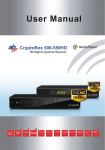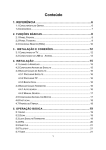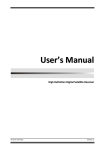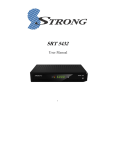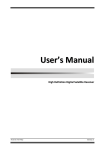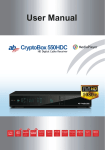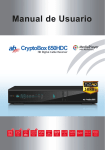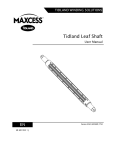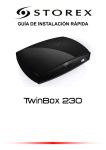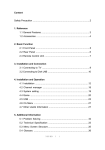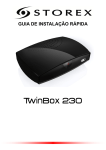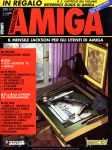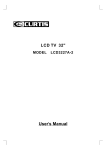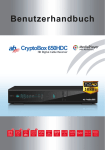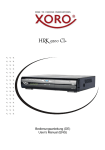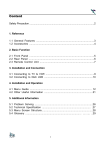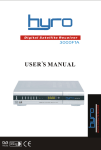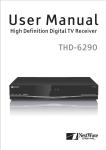Download Manual AB CryptoBox 6xxHD
Transcript
User Manual CryptoBox 600-650HD Content Safety Precaution ....................................................................3 1. Reference ··································································································4 1.1 General Features ·············································································4 1.2 Accessories ·····················································································5 2. Product Overview ·····················································································6 2.1 Front Panel ······················································································6 2.2 Rear Panel ·······················································································8 2.3 Remote Control Unit (RCU)···························································9 3. Connection with Other Device ·······························································11 3.1 Connecting to TV ·········································································11 3.2 Connecting the Antenna ·······························································12 4. Installation ······························································································14 4.1 Powering On ·················································································14 4.2 Antenna Settings ···········································································14 4.3 Fast scan ·······················································································20 4.4 Factory Default ·············································································20 4.5 USALS Setup ···············································································21 5. Channel Manager ····················································································22 5.1 Edit Channel ·················································································22 5.2 Edit Favorite ·················································································23 5.3 Sort Channels ················································································24 5.4 User Channel List ·········································································24 6. Settings ···································································································24 6.1 System Settings·············································································24 6.2 OSD Setup ····················································································26 6.3 Parental control ·············································································26 6.4 Times ····························································································27 6.5 CA Menu ······················································································29 6.6 CI Menu ························································································29 1 6.7 Connecting to the LAN·································································30 6.8 USB Update ··················································································31 6.9 Network Update ············································································31 6.10 About STB ··················································································31 7. X-tras ······································································································31 7.1 Calendar ························································································31 7.2 Games ···························································································32 7.3 Network Apps ···············································································32 8. Multimedia······························································································34 8.1 Basic Operations ···········································································34 8.2 Setting ···························································································35 8.3 Play Files ······················································································37 9. Basic Operation ······················································································41 9.1 Audio ····························································································41 9.2 Satellite List ··················································································41 9.3 EPG ·······························································································42 9.4 Subtitle ··························································································43 9.5 Teletext ·························································································43 9.6 Find channel ·················································································43 9.7 Program Information ····································································44 10. Channel List ··························································································45 10.1 OK List ·······················································································45 10.2 Favorite List ················································································45 11. USB Control ·························································································46 11.1 Recording and Timeshift ····························································46 11.2 PVR List ·····················································································47 12. Additional Information ·········································································48 12.1 Trouble Shooting ········································································48 12.2 Technical Specification ······························································50 12.3 Glossary ······················································································51 2 Safety Precaution This STB has been designed and manufactured to satisfy the international safety standards. Please read the following safety precautions carefully before operating this receiver. Main Supply: Before operating, please check the units operating voltage is 90~250V AC 50/60Hz. Overload: Do not overload a wall outlet, extension cord or adapter, neither use damaged power cord or touch it with wet hand as this may result in electric shock. Liquid: The receiver shall not be exposed to dripping or splashing water, and that no objects filled with liquids, such as base, shall be placed on the apparatus. Ventilation: Keep the slots on top of the receiver uncover to allow sufficient airflow to the unit. Do not put the receiver on soft furnishings or carpets. Do not expose the receiver to direct light or do not place it near a heater or in humid conditions. Do not stack other electronic equipments on top of the receiver. Cleaning: Plug out the receiver from the wall outlet before cleaning. Clean the receiver by a soft cloth or mild solution of washing-up liquid (no solvents). Connection: Disconnect the receiver from the mains when you connect it to satellite LNB or disconnect it from LNB. Failure would possibly cause damage to the LNB. Location: Put the receiver indoor in order to avoid lightening, raining or sunlight. Uncover: Do not remove the cover, to reduce the risk of electric shock. Contact qualified and licensed service personnel to repair the receiver, or contact your dealer. 3 1. Reference 1.1 General Features DVB-S/DVB-S2 Satellite Compliant (MPEG-II/ MPEG-IV/ H.264) SCPC & MCPC receivable from Ku and C band satellites Universal, Single, Single S & C Band Wideband LNB Sensitive Tuner with Loop-Through DiSEqC1.0/1.1/1.2/1.3 (USALS) Unicable Supported Blind search supported Auto DiSEqC Search PAL/NTSC Conversion True full Color (32 bits) on screen display (OSD) Storing memory: 100 satellite, 4000 transponders and 6100 channels 26 favorite group and parental lock supported Multi-language menu supported Multi-language audio supported Multi-language DVB Subtitle output 7 days Electronic Program Guide (EPG) Teletext output through VBI and OSD USB 2.0 Interface CI module Supported Support many network functions 4 1.2 Accessories l Users manual l Remote Control Unit l Batteries Figure 1.Accessories 5 2. Product Overview 2.1 Front Panel Figure 2. Front Panel 1. Power LED Power indicator. 2. Display It displays channel information. In standby mode it displays local time. 3. Power button Switch between operation and standby modes. 4. CH+/CHChange channel in viewing mode and move the cursor up/down in menu mode. 6 Figure 2. Front Panel 1. Power LED Power indicator. 2. Display It displays channel information. In standby mode it displays local time. 3. Power button Switch between operation and standby modes. 4. CH+/CHChange channel in viewing mode and move the cursor up/down in menu mode. 7 2.2 Rear Panel 600HD 650HD Figure 3. Rear Panel 1. LAN Connect to the internet using an Ethernet cable. 2. SPDIF Digital Audio output (Optical). 3. TV SCART Connect to the TV using a Scart cable. 4. DV-OUT Connect to the TV using an HDMI cable. 5. USB2.0 One USB 2.0 Host Port. 6. LOOP OUT Connect another receiver. 7. LNB IN Connect the satellite antenna cable. 8. RS232 Connect to the computer using a serial line. 9. ON/OFF Power on/off. 8 2.3 Remote Control Unit (RCU) You can control this receiver by this remote controller with full function. 1. STANDBY: Switch between operation and standby modes. 2. F1: Accessorial function. 3. SHIFT: Enable/Disable timeshift. 4. MUTE: Mute audio. 5. I I : Pause/Time shift. 6. ◄◄: Fast rewind. 7. ►►:Fast forward. 8. ●: Record.SLEEP: Set sleep time. 9. ►: Play. 10. ■:stop recording and playing. 11. MENU: Activate main menu. 12. EXIT: Exit current menu step by step.. 13. ▲/▼/◄/► :Navigates through the Menus 14. OK: Confirm 15. RELOAD: Move to the previous viewed channel. 16. EPG (Electronic Program Guide): Display the program guide. 17. V+/V- : Change volume in viewing mode. 18. P+/P-: Change program. 19. INFO: Display the program information. 20. FAV: Display favorite channel list you set before. 21. NUMERIC KEY (0~9): Enter a TV/radio channel number or menu option number 22. PAGE-/PAGE+: Page up/down on menu or channel list. 23. MEDIA : Access to the USB menu. 24. SAT: Show the scanned satellite list. Figure 4. Remote 25. SUB: Display the subtitle language list. 26. TV/RAD: Switch between TV and RADIO. 9 Control Unit 27. FIND: Quickly find channels which you want. 28. V-FORMAT: Set the screen mode. 29. TXT: Display the teletext. 30. AUDIO: Display the audio list 10 3. Connection with Other Device The following diagram shows you the connections among receiver, TV, LNB and other equipment, please read this first if you are not sure about the connection, and it will guide you to the correct connection. 3.1 Connecting to TV Figure 5. Connecting to TV & VCR 11 3.2 Connecting the Antenna You can connect one fixed dish LNB directly to the LNB IN, or connect at least two dishes LNB by DiSEqC Switch. Figure6. Connecting to Dish LNB 12 Figure7. Connecting to Dish LNB 13 4. Installation You should install the receiver when powering on your product for the first time after purchase. Tip: The default password is 0000. If you have forgotten your password, please contact your local product distributor. 4.1 Powering On 1. Connect the power cord of the product to a wall outlet. 2. Ensure the ON/OFF switch at the rear of the product is switched to ON. 3. Power on by pressing the STANDBY button on the remote control or the STANDBY button at the front of the product. 4.2 Antenna Settings Antenna Settings allows you to configure the antenna setting parameters. Menu->INTALLATION->Antenna Settings 1. Satellite: Highlight the satellite you want to search. 2. Transponder (TP for short): Press the ◄/► button to change the TP. 3. LNB Type: Press the ◄/► button to change the LNB frequency. 4. LNB Power: Press the ◄/►button to select the required LNB power. 14 5. 22kHz: Press the ◄/► button to select ON, OFF or Auto. 6. DiSEqC 1.0: Press the ◄/► button to select the required DiSEqC1.0 input. 7. DiSEqC 1.1: Press the ◄/► button to select the required DiSEqC1.1 input. 8. Motor: Press the ◄/► button to select DiSEqC1.2 or USALS. 9. Network search: Press the ◄/► button to select ON or OFF if you want to implement network search. 10. Start search: Press the ◄/► button to select Satellite & Multi-Sat & Blind scan & Transponder & Multi-Transponder which you want to start search. 4.2.1 Antenna Settings for Satellite Press the ◄/► or OK button you can see the pre-stored Satellite list, in this menu, you can execute select, Add, Move, Delete, Rename Satellites. Select In this menu, you can press the ▲/▼ keys choose the satellite which you want to use, and then press the OK to confirm the setting. Add Press RED button to add a new satellite. Here you can input new Satellite angle, Satellite Direction (East, West), Band (Ku, C). OK to confirm the setting and this new satellite will be added to the end of the Satellite list. Move In this menu, you can Select the satellite that you want to move from the satellite list by pressing the GREEN button, then press OK, you will be asked to move the satellite to put where, input the destination number and press OK. Then you can move one satellite from one position to another. 15 Delete You can delete the user satellite. Select the satellite that you want to delete from the satellite list. Then press the YELLOW button. You will be asked to confirm whether delete the satellite or not. If you select YES, all the channels and transponders in the selected satellite will be deleted. And the selected satellite will disappear. Rename You can press the BLUE button to change the satellite name. When the keyboard popup, you can select the character which you want to edit the name. 4.2.2 Antenna Settings for Transponder If you change the satellite, the transponder will be changed automatically. You will find the transponder list of selected satellite here. In this menu, Press the ◄/► or OK button you can see the pre-stored Transponder list, and you can execute Select, Add, Delete, Edit Transponders. Select In this menu, you can press the ▲/▼ keys choose the Transponder which you want to use, then press OK to confirm the setting. Add You can press the RED button to add a transponder. Here you can input new Transponder frequency, choose polarization (Ver, Hor), input new symbol rate, and 16 choose FEC (1/2, 2/3, 3/4, 6/5, 7/8, Auto). OK to confirm the settings, and this new Transponder will be added to the TP list in ascend order sorted by frequency. Delete You can delete the Transponder of the satellite. Select the Transponder that you want to delete from the TP list. Then press the GREEN button. You will be asked to confirm whether delete the satellite or not. If you select YES, all the channels in the selected Transponder will be deleted, and the selected Transponder will disappear. Edit Press yellow button to edit. Here you can set the Transponder frequency, polarization, symbol rate and FEC. Delete All Press the BULE button. You can delete all the channels and Transponder in the selected satellite will be deleted. 4.2.3 Search Channels from Satellite A: Satellite Search 1. Highlight the Satellite and press the OK button to enter satellite list. And then select one satellite you want to search. 2. Complete the antenna settings of this satellite. 3. Highlight the Start Search and select satellite then press the OK button to confirm. B: Multi Satellites Search 1. Highlight the Start Search and select Multi satellites then press the OK button. 2. Highlight the satellites in the satellite list, but make sure they are all configured to your DiSEqC Switch before press the OK to mark them. 3. Press Exit will start searching programs of the satellites you have marked. 17 C: Blind Search 1. Highlight the Satellite and press the OK button to enter satellite list. And then select one satellite you want to search. 2. Complete the antenna settings of this satellite. 3. Highlight the Start Search and select Blind Search then press the OK button to confirm. D: TP Search 1. Highlight the Satellite and press the OK button to enter satellite list. And then select one satellite you want to search. 2. Complete the antenna setting of this satellite. 3. Highlight the Transponder and press the OK button to enter TP list. And then select one transponder you want search. 4. Highlight the Start Search and select Transponder then press the OK button to confirm. E: Multi TP Search 1. Highlight the Satellite and press the OK button to enter satellite list. And then select one satellite you want to search. 2. Complete the antenna setting of this satellite. 3. Highlight the Start Search and select TP Search then press the OK button to confirm. 4. Highlight the transponders in the TP list press the OK to mark them. 5. Press Exit will start searching programs of the transponders you have marked. 18 4.2.4 Antenna Settings for Motor Menu-> INTALLATION ->Antenna Settings->Motor 1. Motor Mode: Select DiSEqC 1.2 or USALS using the ◄/► button. DiSEqC 1.2: General motor antenna using DiSEqC 1.2. USALS: Motor antenna using USALS. Move Auto[W/E] Press ◄/► button, the dish will be motorized to East/West continuously, it will stop until it find the best signal. Move west-east Press ◄/► button, the dish will be motorized to East/West step by step, until you find the best signal showed on the signal bar. Fine Tuning(1) Input digital button to set the moving step Store Position Save the current position you searched. Go to Position Press OK button to move the dish to the position which you saved. Go to Reference Press OK button to move the dish to 0 position. 19 Set West Limit You can set the maximum motor limit for both West to prevent damage to the antenna. Set East Limit You can set the maximum motor limit for both East to prevent damage to the antenna. Disable Limit Disable West limit and East limit. Go to X.X Press OK button to move the dish to the USALS Setup. Tip: Before you use USALS, you should go to Main Menu → INSTALLATION→ USALS Setup to set you local position firstly. 4.3 Fast scan To fast search channels by different providers base on Astra (19.2) satellite and the 12515 transponders. 4.4 Factory Default You can restore the product to the factory default and you can also setup it according to the wizard. Warning: Please note that once you perform Factory Default all, all data and settings will be deleted. 1. Menu->INSTALLTION -> Factory Default 20 2. Input the password. 3. Highlight the option you want and press the OK button to execute it. Tip: If you select “yes”, all data and setting will be lost. Then waiting a moment, you will view the OSD language menu where you can select the language according your mind. 1) All: All data and settings will be deleted. 2) Channel List Only: All channels data will be deleted. 3) Radio Channel Only: All radio channels data will be deleted. 4) Scramble Channel Only: All scramble channels data will be deleted. 5) TP Channel Only: All the channels data in the selected Transponder will be deleted. 6) SAT Channel Only: All the channels data in the selected satellite will be deleted. 4.5 USALS Setup Menu-> INSTALLATION ->USALS Setup If you set the Motor Mode to USALS, you need set the longitude and the latitude in USALS Setup. 21 5. Channel Manager Tip: You can press the Sat button to choose different satellite according to the help information, press OK to confirm, then all the channels of this sat will be display. 5.1 Edit Channel Menu->EDIT CHANNEL->TV Channels / Radio Channels Edit Channels enables you to move, delete, rename, lock/unlock, swap the channels in the channel list conveniently. Tip: Radio Channels operation similar to the TV Channels. 1. Move Channels 1) Press RED button to enter move mode. 2) Highlight the channel you want to move and press OK to select the channel. 3) Press the ▲/▼ button to the destination in the channel list and press the OK button. 1.1 Move Group Channels 1) Highlight the channel you want to group move. Then press the BLUE button to sign the channel. 2) Press the ▲/▼ or ◄/► button to highlight other channels you want to group move. Then press the BLUE button to sign the channel one by one. 3) Press the ▲/▼ to the destination in the channel list and press OK to confirm. 22 2. Delete Channels 1) Highlight the Delete function using ◄/► button or press GREEN button directly. 2) Press the ▲/▼ to highlight the channel you want to delete, press the OK button to sign the channel. 3) Press the EXIT button, here, select Yes will delete the chosen channels. 3. Lock/unlock Channels 1) Highlight the Lock function using ◄/► button or press YELLOW button directly. 2) Highlight the channel you want to lock, press the OK button to confirm. 3) Input the password to lock the channel. If you want to lock another channel, you will not be asked to Input the password again until you press EXIT. Note: If the highlighted channel is locked, press the OK button is switched into Unlock. 4. Rename Channels 1) Highlight the Rename function using ◄/► button or press BLUE button directly. 2) Highlight the channel you want to rename, press the OK button. 3) Enter a channel name directly using the keyboard displayed on the screen and press the BLUE button to complete. 5.2 Edit Favorite Menu->EDIT CHANNEL-> Favorites You can add or remove channels from the favorite groups. 1. Highlight the channels you want to add or remove from the favorite 23 channel list. 2. Press the ◄/► button to change the favorite group and press the OK button to mark the channel as selected favorite group. And you also can press the color button directly to add the channel to the corresponding favorite group. 3. Press the EXIT button to exit the menu and save it. Note: If you select a favorite list, press the CH+/CH- button can only change the channels in this favorite list and press the OK button can only display the channels in this favorite list. 5.3 Sort Channels You can sort the channels list. Menu-> EDIT CHANNEL ->Sort Channels Highlight the option you want and press the OK button to sort the channel list. You can sort by Alphabet, Transponder, FTAToCAS, Favor and Default. 5.4 User Channel List User Channel List allows you to save or load all the data and settings. 1. Menu->EDIT CHANNEL-> User Channel List->Save User Data 2. Menu->EDIT CHANNEL-> User Channel List->Load User Data 6. Settings 6.1 System Settings Menu->SETTINGS->System Settings 24 Tip: You can set all the settings here by pressing ◄ /► button. 1. Menu Language: Set the menu language. 2. Audio1: Set the preferred audio language. 3. Audio2: Set the sub-prime audio language. 4. Subtitle Language: Set the subtitle language. 5. EPG Language: Set the EPG language. 6. TXT Language: Set the TXT language. 7. Digital Audio: If a channel has AC3 and PCM audio language at the same time, when you select RAW it will set AC3 audio language as default output and when you select PCM it will set PCM audio language as default output. 8. Scart Output:While the HDMI Mode is set to 576i or 480i mode, you can change the scart output mode between CVBS and RGB mode. 9. Auto Channel Selection: If you set ON, in the channel list will play automatically when you highlight the channel. If you set OFF, in the channel list when you highlight the channel, you should press the OK button to play it. 10. Auto Exit CH List: If you set ON, the channel list will disappear when you press OK on a Highlighted channel. If you set OFF, the channel list will disappear when you press OK on a playing channel. 11. Recall List: You can turn Recall List on or off. If you set ON, when you press 25 Recall button of RCU you can get the recall list. If you set OFF, when you press recall button you can go back to the last program you have selected. 12. Low Power Standby:You can turn Low Power Standby on or off. 13. Standby Time: You can set the Standby Time on or off. 14. Front Panel Light: Set the brightness of the LED. 15. Front Panel Display: Set the LED display channel or clock. 16. Enable X-TimeShift 17. Ch. List Typ 6.2 OSD Setup Menu->SETTINGS->OSD Setup 1. Menu Transparency: Set the transparency of all menus. 2. TXT Transparency: Set the transparency of teletext. 3. Display Mode: Set the HD format between 1080p, 1080i, 720p, 576i or 576p. 4. TV Type: Set the TV Type on PAL/NTSC/Auto state. 5. Screen Mode: Set the display format according to the screen ratio. Select TV screen mode either 4:3 or 16:9 according to the TV type, or press the MODE button of RCU directly. 1.6. OSD Timeout: Set the display time of the program information. 6.3 Parental control Menu-> SETTINGS ->Parental Control Parental Control allows you to set limits for each program or change your previous 26 password. You can also lock the changes you have made using Installation Lock, Edit Channel Lock and System Lock. And you can change Age Rating. 6.4 Times Menu-> SETTINGS ->Times 6.4.1 Time Settings Menu-> SETTINGS ->Times->Time Settings Time Settings will set the time mode, time zone and summer time. 1.Time Mode You can switch the Time Mode to Auto or Manual by pressing ◄/► button. If the Time Mode is Manual you can change the current time and current date. 2. Time Offset Set the time zone according to your city. 3. Summer Time If your region needs summer time to correct the current time please make it ON by pressing ◄/► button. 4. Time You can selete network or satellite. 27 6.4.2 Event Timer Event Timer You can set 8 timer events. It will record or play the program automatically according to the timer event list that you set. 1. Menu-> SETTINGS ->TIMES-> Event Timer or press the TIMER button directly. 2. Press the GREEN button to setup a timer, and press the OK button to save the timer after setup. Channel Select the Channel from Channel List. Date Input start date of the timer. Start/Stop Set Start and Stop time of the timer. Repeat <1X> only one time. <Day> Repeat every day. <Weekly> Repeat the channel weekly. <1-5> Repeat the channel from Monday to Friday. <6-7> Repeat the channel from Saturday to Sunday. Standby when Stop If set YES, the receiver will go to standby mode after the timer, if set NO it won’t be standby. Time Record If set YES, only if there is a USB device, it will be recorded automatically when the timer is started. And the recorded PVR will be saved in USB device. If set NO, it will not be recorded. 3. In Event Timer menu, highlight one event, press the RED button will cancel this timer and press the YELLOW button can go to edit this timer. 28 6.4.3 Sleep Timer SLEEP Timer can set the automatic turn off time. 1. Menu->SETTINGS ->TIMES-> Sleep Timer. 2. Press the ◄/► button to select the option or input the number at “-- M” option. 3. Press the OK button to save. 6.4.4 APD Settings APD Setting can set the power turn down automatically. 6.5 CA Menu You must insert the smart card with gold chip down into CA slot. Menu-> SETTINGS ->CA Menu You can view the information about CA card. 6.6 CI Menu If you want to watch Pay-TV, then you need a CI module with a appropriate subscription card. (CI Menu - only for model 650HD) Menu-> SETTINGS ->CI Menu 1.Push the smart card in the CI module. The Golden Chip must show up. And the smart card standard must correspond to CI 29 module. Then insert the CI Module to the CI slot. 2.You can read the detail information about the smart card and CI module after it initialized OK. 3. The Pay-TV which correspond to CI module standard can be decoded. 6.7 Connecting to the LAN 6.7.1 IP Setting 1. Connect one end of the Ethernet cable to the product and the other end to the LAN router. 2. Menu-> SETTINGS ->IP Setting If the Ethernet cable is connected fine, it will display “Connect”. In this menu, you can set IP address manually, also you can get IP address automatically. RED: Get IP address automatically. GREEN: Test the network if connect correctly. 6.7.2 Connecting to the Wi-Fi (Wireless LAN) 1. Plug in the wireless USB dongle to the USB port. 2. Enter Menu->SETTINGS->Wireless Setting->Search Access Pointer. 3. Select the network name of your Wi-Fi access point from the list. 4. Press the OK button, then input the right password. And you can press YELLOW button to disable/enable the WI-FI. 5. Enter Menu-> SETTINGS->Wireless Setting->IP Setting. If the Network is connected, it should get the correct IP address and display the “Connect”. 30 6.8 USB Update Menu-> SETTINGS ->USB update USB Update can update software by using USB HDD or USB disk. 6.9 Network Update Menu-> SETTINGS ->Network update Network Update can update software by network. 6.10 About STB Menu-> SETTINGS ->ABOUT STB ABOUT STB can get the information about the STB, such as product name, software & hardware version, and serial number and so on. When you need service from the dealer you need to submit this information in order go get the correct and fast after sales service. 7. X-tras 7.1 Calendar Menu->X-tras-> calendar Calendar can get the date information. And you can add the memo of the day. 31 7.2 Games Menu->X-tras-> games Games offer 9 funny games you can play. 7.3 Network Apps 7.3.1 FTP Download You can Download S/W, music, photo and other media files from the FTP. 1. Menu->X-tras -> Network Apps->FTP Download 2. Input the correct information for every option. 3. Highlight on the Connect Net, press the OK button to enter the FTP. 4. According to the prompted information select the file you want to download and press the OK button to download it to USB device. 5. Press the RED button to enter the FTP_DOWNLOAD folder in USB. 7.3.2 Weather Forecast Menu->X-tras ->Network Apps->Weather Here you can input the city name to browse the weather of this city in future 5 days. RED: Change the city and unit of temperature. 32 7.3.3 RSS Menu-> X-tras->Network Apps ->RSS You can press the RED button to add the RSS websites and then you can read content of the websites. And also you can press the YELLOW button to delete the RSS websites. 7.3.4 Currency Converter You can inquires the currency conversion. Menu-> X-tras->Network Apps ->Currency Converter 7.3.5 Stock View You can view stock information. Menu-> X-tras->Network Apps ->Stock View 7.3.6 IPTV You can visit the IPTV To add a site to visit. 33 8. Multimedia Menu->Multimedia or press the MEDIA button directly Multimedia can play many kinds of media files, you can record program and playback it and you can do various operations when using USB HDD or USB disk. Note: It supports FAT, FAT32 and NTFS format USB disk or USB HDD. 8.1 Basic Operations 1. Tool Rename Files 1) Highlight the file or folder. 2) Press the RED button and Highlight the Rename. 3) Press the OK button can rename the file or folder. Delete Files 1) Highlight the file or folder. 2) Press the RED button and Highlight the Delete. 3) Press the OK button can delete the file or folder. Move Files 1) Highlight the file or folder. 2) Press the RED button and Highlight the Move To. 3) Select a destination folder. 4) Press the OK button to move the highlight folder or file to destination folder. Copy Files 34 1) Highlight the file or folder. 2) Press the RED button and Highlight the Copy To. 3) Select another disk partition. 4) Press the OK button to copy the highlight folder or file to disk partition which you selected. Create New Folder 1) Press the RED button and Highlight the Create New Folder. 2) Press the OK button to create a new folder in current folder. Sort 1) Press the RED button and Highlight the Sort. 2) Select the sort type. (First Name/Date/Size) 3) Press the OK button to sort by sort type which you selected. Format Disk 1) Highlight a disk partition or enter a disk partition. 2) Press the RED button and Highlight the Format Disk. 3) Press the OK button and then select a format mode (Fat and NTFS). Then press OK button to confirm format. After formatting, all the files in current disk partition will be lost. 2. Upload Upload Data to USB 1) Enter the USB disk. 2) Press the YELLOW button and highlight the Upload Data to USB. 3) Press the OK button can upload the data and setting to usb disk. Upload to FTP 1) Highlight the file or folder. 2) Press the YELLOW button and highlight the Upload to FTP. 3) Press the OK button can upload the highlight file or folder to FTP. 8.2 Setting 35 1. Play Mode Loop Set the Loop state on Normal, Reverse, Random, Single or Off. Slide Show Interval Set the Slide Show Interval from 2S-10S. Photo View Mode Set the Photo View Mode state on Full Screen, 2x2 Thumbnail or 2x3 Thumbnail. 2. PVR Setting Record Partition Select the Partition where save your record or other result of your operation. Record Mode Set the Record Mode Channel or Transponder. Record Type Set the Record Type TS or PS. Record Time Set the Record Default Time off, 30, 60, 90, 120 minute or input number directly. Auto Timeshift Set start the Timeshift if automaticly. Timeshift Buffer Size(MB) Set the Timeshift Buffer Size off, 100, 200, 400, 800, 1600, 3200, 6400MB. Timeshift Need Save 36 Set the Timeshift if need to save in USB device. Timeshift To Record It allows you to whether add the content of auto timeshifted into recorded file or not. Play Start Pos When playing the PVR file, set the Play Start Pos whether head of the file or last pos (Stop play by manual last time) of the file. 8.3 Play Files 1. Music 1) Press the ◄/► to highlight the Music. 2) Press the ▲/▼ to change the folder or file and press the OK button to open the folder or play the music file. OK: Play the selected file. ▲/▼: Change the highlighted item. ►: Play the file. ■ : Stop playing file. I◄◄: Play the previous file. ►►I: Play the next file. ◄◄: Fast rewind. ►►: Fast forward. PAUSE/||: Pause. VOL+/VOL-: Adjust volume. EXIT: Exit playing state and return to file list menu. 2. Picture 1) Press the ◄/► to highlight the Picture. 2) Press the ▲/▼ to change the 37 folder or file and press the OK button to open the folder or play the picture. Tip: You can press the Green button to go to Play Mode Set the Photo View Mode state on Full Screen, 2x2 Thumbnail or 2x3 Thumbnail in the USB menu. The picture followed is 2x2 Thumbnail mode. OK: View the photo. ▲/▼/◄/►: Highlighted the previous/next photo when photo view mode is 2x2 Thumbnail or 2x3 Thumbnail. ◄/► button also can rotate the picture when photo display of full screen. I◄◄: Play the previous file. ►►I: Play the next file. PAUSE/||: Pause. EXIT: Exit the current menu. 3. Movie 1) Press the ◄/► to highlight the Movie. 2) Press the ▲/▼ to change the folder or file and press the OK button to open the folder or play the movie file. OK: View play list or play the highlighted file in the play list. ►: Play the file. PAUSE/||:Pause. ■: Stop playing file. ◄◄: Fast rewind. ►►: Fast forward. I◄◄: Play the previous item. ►►I: Play the next item. INFO: Display the playing progress. In this menu, press the INFO button again to display the file’s detail information. AUDIO: Set the audio language. SUB: If the file has subtitle, press the SUB button can change the subtitle. VOL+/VOL- : Adjust volume. Find&(0-9): Jump to position as you like. 38 EXIT: Exit the current menu. 4. PVR 1) Press the ◄/► to highlight the PVR. 2) Press the ▲/▼ to change the folder or file and press the OK button to open the folder or play the PVR file. You can playback the files you recorded. And the recorded files are saved in folder named ALIDVRS2. OK: View play list or play the highlighted file in the play list. ►: Display playing progress. PAUSE/||: Pause or Step. ■: Stop playing file. ◄◄: Fast rewind. ►►: Fast forward. I◄◄: Play the previous item. ►►I: Play the next item. INFO: Display playing progress. In this menu, press the INFO button again to display the EPG information. AUDIO: Set the audio language. SUB: If the file has subtitle, press the SUB button can change the subtitle. TXT:If the file has teletext, press the TXT button can display the teletext. CH+: Mark on current time when info bar display. CH-: Jump to mark when info bar display. Find&(0-9): Jump to the valid time that you input. ◄/►: Jump to forward or rewind of a time interval when info bar display. EXIT: Exit the current menu. 5. Play List You can play the movie/photo/music/PVR files in the Play List. 1) In the USB Menu highlight a movie/ photo/music/PVR file and press the FAV button to mark it, then press the GREEN button to enter the Play List menu, you will see the files marked included in play list. 39 2) In the movie/ photo/music/PVR Play List, press FAV key to add the all available files to the Play List. (Just according to the help information) 3) In the movie/ photo/music/PVR Play List, highlight the movie/photo/music/PVR file and press the Red button to mark it, then move it to the destination press OK to confirm, then you can move the marked file to destination. 4) Press the GREEN button set the Play Mode. 5) Press YELLOW key to delete highlighted file from Play List. 6) Press the BLUE button to delete all files from Play list. 40 9. Basic Operation 9.1 Audio You can select the language you prefer in Audio if the current program is available in multiple audio languages. 1. Press the AUDIO button. 2. Press ▲ / ▼ button and then press the OK button to select the audio language you prefer. 3. Select audio direction (Left, Right, Stereo) using the ◄/► button. 4. Press the EXIT button to close. 9.2 Satellite List You can select or hide the satellite that you want. 1. Press the SAT button. 2. Highlight the satellite that you want. 3. Press the OK button, then it can enter the channel list which only includes the channels of this satellite. 4. Press the RED button to hide or show the satellite. If it is hidden, the channels of this satellite will be hidden in the channel list. 5. Press the Green button to delete the satellite. And all the channels in this satellite will be deleted. 41 9.3 EPG You can view the EPG information of all channels in time and date order. 1. Press the EPG button. 2. Press the GREEN button to switch EPG mode between Weekly EPG and Day EPG. Weekly EPG: 1) Press the ▲/▼ button to change program. 2) Press the ◄ /► button to change the date, and it displays the EPG list in one day of the selected channel. 3) Press OK button, then press ▲/ ▼ button to highlight the EPG event which you want, and the current EPG detail information will display on the bottom of screen. Highlight the EPG event which you want, press the Record button to enter Timer Setup menu. After setup, press the OK button can add the EPG event to the Timer. Day EPG: 1) Press the ▲/▼button to change channel. 2) Press the ◄ /► button to change EPG event of the highlighted channel. 3) Highlight the EPG event which you want, press the Record button to enter 42 Timer Setup menu. After setup, press the OK button can add the EPG event to the Timer. 9.4 Subtitle You can select the language for the subtitle if the program provides subtitle information. 1. Press the SUB button. 2. Select the required subtitle language and press the OK button. The subtitle of the selected language will be displayed at the bottom of the screen. 9.5 Teletext You can view the teletext information of this program. 1. Press the TXT button. 2. Press the ▲/▼ button to page up or page down. 3. Press the NUMERIC(0-9) buttons can go to the designated page directly. 4. Press the color button can back to the previous page. 9.6 Find channel You can find the channels you want quickly just by pressing the FIND button directly. Or by pressing Blue button in OK List/FAV List. 43 9.7 Program Information You can view the program information by pressing the INFO button while watching a program. 1. General Information : It is a FTA program . : It is a scramble program. : The sound of current program is not Dolby. : The sound of current program is Dolby. : Current program has no EPG information. : Current program has EPG information. : Current program has no teletext information. : Current program has teletext information. : Current program is unlocked. : Current program is locked. : Current program is not a HD program. : Current program is a HD program. 2. EPG Information Press the INFO button twice to view detailed EPG information, press the ◄/► to switch current and next and press the INFO button once more to hide the detailed EPG information. 44 10. Channel List This chapter will help you manipulate the channel list. Tip: You can press the Sat button to choose different satellite when you are operating on a channel list, press OK to confirm, then all the channels of this sat will be display. 10.1 OK List 1) Press the OK button to enter the channel list while watching a program. 2) Press the ◄/► button to switch the channel list type. (All Channels/FTA Channels/Scramble Channels/HD Channels) 3) Press the RED button to sort the channels. Highlight the option you want and press the OK button to sort the channel list. Note: The Original Channel List is back to the channel list you sort it last time. 4) Press the GREEN button to list the channels by transponder. 5) Press the YELLOW button can help you find the channel quick by the first character of name. 6) Press the BLUE button to enter the Quick Find menu. 10.2 Favorite List 45 1) If you have set several favorite lists, press the FAV button can enter the favorite list. 2) Press the ◄/► button to change different favorite list and press the OK button can select the a program in current favorite list. 3) Press the RED button to sort the channels of the favorite list. 4) Press the GREEN button to manipulate the favorite list channels (move, delete, rename, lock/unlock, swap the channels of the favorite list). 5) Press the YELLOW button can help you find out channels quick by their first name. 6) Press the BLUE button can help you quickly find the channel you want. Note: If you selected a favorite list, press the CH+/CH- button can only change the channels in this favorite list and press the OK button can only display the channels in this favorite list. 11. USB Control 11.1 Recording and Timeshift 1. Start Recording 1) You can press the ● button to start recording while watching program. 2) If you have set the timer, and set the Time Record on, it will start recording automatically according to the start time of the timer. 2. Stop Recording 46 1) You can press the ■ button to stop recording. If you don’t press the ■ button, it will stop recording according to the record duration. 2) If you have set the timer, it will stop recording automatically according to the stop time of the timer. 3) If the free space on the USB HDD or USB disk is insufficient, recording will stop. 3. Other Operations while Recording While the recording channel is current channel, press the INFO button can display the recording time. And press the INFO button twice can display the detail information of the recording. Press the ► button will enter the playback mode. Press the ● button can set the record duration. Press the PAUSE/|| button can pause recording, and continue recording by press PAUSE/|| button again. Press the ◄◄/►► button can fast rewind or fast forward in playback mode. 4. Timeshift Timeshifte allows you to pause a live broadcast and return to it later and continue where you left off. Press the || button to start timeshift. While it is in timeshift mode, press the ► button can play the program, press the INFO button can display the recording information, press the PAUSE/|| button can pause or play the program, press the ◄◄/►► button can fast rewind or fast forward. Press the ■ button to stop timeshift. If you change to another program or do other operations, it will stop timeshift but still record. 11.2 PVR List You can enter the PVR list directly and then play the PVR file. In the PVR list you also can delete the PVR files. 1. Press ► button enter the PVR list when watching program. 2. Press the ▲/▼ to highlight the PVR 47 file you want to play, press the OK button to play in small screen. 3. You can press BLUE button to play the PVR file in full screen. And press Exit button will return to the PVR List. 4. If you want to delete PVR files, first you must press the ▲/▼ to highlight the PVR file you want to delete, and press the YELLOW button to delete. 12. Additional Information 12.1 Trouble Shooting Before contacting your local service centre, please read the tips below carefully. If the problem persists after completing the following procedure, please contact your local product distributor or service centre for further instructions. 1. No message displayed on the front display. (The product will not switch on.) • Check the main power cable and make sure it is plugged into a suitable power outlet. • Check that the mains supply is switched on. • Connect the power cable to a different power outlet. • Check that the power switch is on at the rear of the product. (where applicable) 2. No picture • Make sure that the product is powered on and in operation mode. (Press the STANDBY button) • Make sure that the AV/HDMI/YUV cable is firmly connected to the TV. • Make sure that the antenna cable is properly connected to the product. • Be sure to activate channel search. • Check the brightness level of the TV. • Check if the channel is currently on air. Contact the broadcaster to ensure that the channel is running. 48 3. Poor picture/sound quality • Make sure there is no mobile phone or microwave oven near the product. • [Satellite] Check that your dish alignment is correct. • [Satellite] Change the satellite dish for a larger one as this will increase the signal levels received. • [Satellite] Replace the LNB with a lower noise factor in cases where the noise factor is too high. • [Satellite] Replace the LNB with a new one in case it is damaged or out of order. • [Satellite] Check the signal levels and adjust your antenna if the level is too low. The signal level may be affected by weather conditions. • [Terrestrial] Adjust the antenna direction to get a better picture. • [Terrestrial] Set the antenna power in menu to On, if you use the active antenna to improve the reception.(where applicable) 4. No or poor sound • Check that your AV/HDMI cable is connected correctly. • Check the volume levels of your TV set and the product. • Check if the product or TV is on mute. • Check audio type or soundtrack option. (where applicable) 5. Remote control does not operate. • To control the product, the top end of the remote control should point directly towards the receiving part of the product. • Remove and reinsert the batteries in the remote control. • Replace the batteries in the remote control for a new set. 6. Cannot connect network . • Make sure the network of your family is good. • Make sure the Ethernet cable is inserted firmly to the LAN router. • Make sure the Wi-Fi can work on other device. • Input the Wi-Fi password again. • Get auto IP again. • Restart the receiver again. 49 12.2 Technical Specification Tuner & Channel No. of Tuners 1 Frequency Range 950 MHz to 2150 MHz Signal Level -25 to -65 dBm LNB Power 13V/18V/14V/19VOFF, Imax = 400mA LNB Tone Switch 22KHz+/-2KHz, 0.6Vpp+/-0.2V DiSEqC Control Version DiSEq C 1.0/1.1/1.2/1.3(USALS)Compatible, Tone burst A/B MPEG Transport Stream MPEG-2 ISO/IEC 13818Transport stream specification Profile Level MPEG1,MPEG-2 MP@ML,H.264, VC1, DV, DivX, and MPEG4 Input Rate 80 Mbps for MPEG Transport Stream and 25 Mbps for DV streams Aspect Ratio 4:3, 16:9 Video Resolution 576i, 576p, 480i, 480p, 720p50, 720p60, 1080i.1080p Audio Decoding MPEG-2 layer I and II (Music cam),MPEG4 AAC and MPEG4 AAC-HE (AAC+),Dolby Digital (AC-3) with bit rates up to 640 K bits /s, LPCM up to 48 KHz,MP3. Audio Mode Single channel/Dual channel/Joint stereo/Stereo Sampling 32, 44.1 and 48 KHz Power Supply Input Voltage AC 100 ~240V, 50/60Hz Power Consumption Max. 25 W Protection Separate internal fuse. Input shall have lightening Protection Physical Specification Weight (Net) About 2.5kg Operating Temp 0℃ to + 40℃ Storage Temp -40℃ to + 65℃ 50 12.3 Glossary Antenna A device that collects and radiates electromagnetic waves. Includes a satellite dish and broadband antenna. EPG An electronic equivalent to a printed television listings magazine; it is an application used with digital set top boxes and digital television sets to list current and scheduled programs that are or will be available on each channel, including a short summary or commentary for each program. The information supplied in the EPG is sent and updated by the channel broadcaster. DiSEqC DiSEqC(Digital Satellite Equipment Control)system, it is a communication bus between satellite receivers and peripheral equipment using only the existing coaxial cable. DVB The Digital Video Broadcast group was created to establish a technical framework for the introduction of digital video broadcasting systems. LNB (low-noise block converter) or LNBF An electronic unit mounted on the satellite dish. It receives the signals reflected by the dish and converts them to signals that can be used by the digital satellite receiver. HDMI (High-Definition Multimedia Interface) An all-digital audio/video interface that supports standard, enhanced, or high-definition video, plus multi-channel digital audio on a single cable. It transmits all ATSC HDTV standards and supports 8-channel digital audio. GHz The prefix giga means milliard, and Hertz means cycles per second. Signals in the GHz range are often called microwaves. 51 MHz The prefix mega means million, and Hertz means cycles per second. MPEG Moving Picture Experts Group. Established by the International Standards Organization to provide the basis for a picture coding and compression system. Forward Error Correction(FEC) A system of error control for data transmission. Polarization Polarization allows several programmers to be fit into the same frequency band. The signals from a satellite are transmitted either with linear (vertical or horizontal) polarizations or circular (right or left) polarization. QPSK(Quaternary Phase Shift Keying) Phase-shift keying in which four different phase angles are used. Transponder An automatic device that receives, amplifies and retransmits a signal on a different frequency. Symbol rate Speed of the digital transmission. Scrambled TV programmer Some TV programmer are transmitted in scrambled form. 52 CryptoBox 600-650HD


























































